This picture
gallery summarizes the molluscs found in tidepools at Playa Estacion,
Puerto Penasco, Sonora, Mexico.
It should be
used to complete lab activity 9.3.
|
Pinctada
mazatlanica
|
|
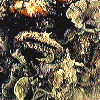
|
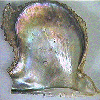 |
"Pearl
oyster"
| Phylum |
Mollusca |
| Class |
Pelecypoda |
| Order |
Pterioida |
| Family |
Pteriidae |
|
|
| Morphology |
Shell
is heavy, 4 to 5 inches long, brown outside with a flaky periostracum,
and with a beautiful, smooth, iridescent, blue inside. Attach
to rocks by byssal threads. |
| Feeding |
Filter feeding |
| Defense |
Not easily removed
from rocks. Can tightly close valves. |
| Reproduction |
Separate sexes
and spawning |
| Habitat |
Low intertidal
and shallow subtidal rocks in sandy and muddy areas |
| Distribution |
Lower Pacific
Baja, throughout the Gulf of California, south to Peru |
| Other |
Produce pearls
and shell is valued for buttons. Over harvesting has closed
the commercial pearl industry that once thrived in the Gulf
of California. |
|
|
Lima
pacifica
|
 |
"Swimming
file shell"
| Phylum |
Mollusca |
| Class |
Pelecypoda |
| Order |
Pterioida |
| Family |
Limidae |
|
| Morphology |
Long,
narrow, textured, white shell to 1.5 inches long. Mantle is
fringed by many long tentacles that are visible even when the
shells are closed. Lightly attaches to rocks with byssal threads. |
| Feeding |
Filter feeding |
| Defense |
Capable of swimming
by clapping its valves. Sticky tentacles break loose when disturbed. |
| Reproduction |
Separate sexes
and spawning |
| Habitat |
Under subtidal
rocks and intertidal tidepool rocks |
| Distribution |
Gulf of California
to Peru |
| Other |
|
|
|
Turbo
fluctuosus
|
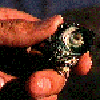 |
"Turban
shell"
| Phylum |
Mollusca |
| Class |
Gastropoda |
| Order |
Archeogastropoda |
| Family |
Turbinidae |
|
| Morphology |
Top-shaped
shell with a heavy calcarous operculum. Color is variable, from
bright orange to dark green. Commonly 2.5 inches. |
| Feeding |
Grazes on algae. |
| Defense |
Closes its shell
aperature with a hard, calcareous operculum |
| Reproduction |
|
| Habitat |
Abundant on
rocky shores. |
| Distribution |
Throughout the
Gulf of California and south to Peru and Ecuador |
| Other |
Operculum is
collected for jewelry. Best observed at night. |
|
|
Solenosteira
macrospira
|
 |
"Large-coiled
welk"
| Phylum |
Mollusca |
| Class |
Gastropoda |
| Order |
Neogastropoda |
| Family |
Buccinidae |
|
| Morphology |
Tan
to brown; white lips; fibrous periostracum. |
| Feeding |
Scavengersthat
feed on dead animals |
| Defense |
Thick shell |
| Reproduction |
Females deposit
egg cases on shell of males |
| Habitat |
Intertidally
on sand and rocks. |
| Distribution |
Northern Gulf
of California |
| Other |
|
|
|
Aplysia
californica
|
|
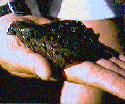
|
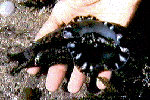 |
"Sea
hare"
| Phylum |
Mollusca |
| Class |
Gastropoda |
| Order |
Anaspida |
| Family |
Aplysiidae |
|
|
| Morphology |
Animal
mottled brown with green streaks and spots. Body length 6-30
inches. Large humped body and has a dorsal-projecting flap on
each side. The small, partly calcified shell is flattened and
located embedded in the mantle tissues between the flaps. |
| Feeding |
Feeds on various
species of red and green algae. |
| Defense |
May emit a purple
defensive secretion when disturbed. |
| Reproduction |
Cross copulating
hermaphrodites. Deposit long, tangled skeins of yellow, yellow-green,
or pink eggs. Each individual is capable of laying over 750,000
eggs in one season. |
| Habitat |
Subtidal rocks
and rocky tidepools |
| Distribution |
Northern California
to the northern Gulf of California. |
| Other |
|
|
|
Berthellina
ilisima
|
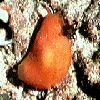 |
"Apricot
slug"
| Phylum |
Mollusca |
| Class |
Gastropoda |
| Order |
Notaspidea |
| Family |
Pleurobranchidae |
|
| Morphology |
A
smooth, uniformly orange slug with two antennae on its head.
It has a small internal shell and a gill located under the mantle
on the right side of the body. Up to 2.5 inches long. |
| Feeding |
Feeds on cnidarians
especially anemones |
| Defense |
Skin secretes
defensive sulfuric acid. |
| Reproduction |
Hermaphroditic.
Deposits eggs on rocks or seaweeds as pale orange masses laid
in wide, spiral ribbons. |
| Habitat |
Subtidal rocks
and rocky tidepools |
| Distribution |
Throughout the
Gulf of California |
| Other |
|
|
|
Tridachiella
diomedea
|
 |
"Mexican
dancer"
| Phylum |
Mollusca |
| Class |
Gastropoda |
| Order |
Sacoglossa |
| Family |
Elysiidae |
|
| Morphology |
Light
black or blackish green, shelless slug with frilled mantle margins
and with two antennae on its head. They are very colorful, often
with blue, purple and orange markings. Up to 2 inches long. |
| Feeding |
Feeds on seaweed
and green algae and retains symbiotic chloroplasts in its tissues. |
| Defense |
Unpalatable |
| Reproduction |
Hermaphroditic |
| Habitat |
Subtidal rocks
and rocky tidepools |
| Distribution |
Gulf of California
to Panama |
| Other |
|
|
|
Hypselodoris
californiensis
|
 |
"Blue
and gold nudibranch"
| Phylum |
Mollusca |
| Class |
Gastropoda |
| Order |
Nudibranchia |
| Family |
Chromodorididae |
|
| Morphology |
Dark
blue, shelless slug with a circlet of gills on its back and
two antennae on its head. They have bright yellow spots and
iridescent sky-blue stripes. Up to 2.5 inches long. |
| Feeding |
Grazes on colonial
invertebrates |
| Defense |
Unpalatable |
| Reproduction |
Hermaphroditic |
| Habitat |
Subtidal rocks
and rocky tidepools |
| Distribution |
Central California,
throughout the Gulf of California and south to southern Mexico |
| Other |
|
|
|
Glossodoris
sedna
|
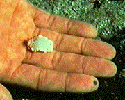 |
"Sedna
nudibranch"
| Phylum |
Mollusca |
| Class |
Gastropoda |
| Order |
Nudibranchia |
| Family |
Chromodorididae |
|
| Morphology |
White,
shelless slug with a circlet of gills on its back and two antennae
on its head. Three stripes encircle the foot: one white, one
yellow, and one red. The gills and antennae are tipped in red.
Up to 2.5 inches long. |
| Feeding |
Graze on sponges |
| Defense |
Defensive terpene
secretions similar to metabolites of prey sponges |
| Reproduction |
Hermaphroditic |
| Habitat |
Subtidal rocks
and rocky tidepools |
| Distribution |
Lower Pacific
Baja and throughout the Gulf of California |
| Other |
|
|
|










